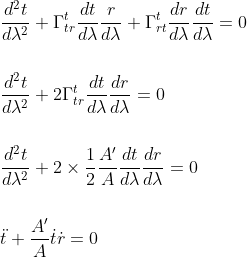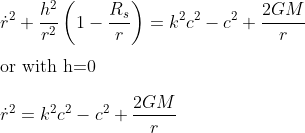We saw in our previous articles Geodesic equation and Christoffel symbols and Geodesic that geodesic equations describe the paths of free falling particles in spacetime.
In order to understand how objects move in Schwarzschild spacetime, we therefore require the geodesic equations defined by the Schwarzschild metric.
We have shown that those equations are in the form of parameterised curves [1]

Replacing α by the four variables t, r, φ and θ gives us four complicated-looking differential Schwarzschild equations
For α = t, looking at the values of Γtμν from our previous article, we see that only Γttr and Γtrt are not null, leading to

Looking at α = r, we know that the four diagonal elements of the matrix Γrμν are not null

so that we can write

If we replace now α by θ, and reminding us the Γθμν matrix, we can write

Finally, we retrieve the last geodesic equation by replacing α by Φ
This section of the article is only available for our subscribers. Please click here to subscribe to a subscription plan to view this part of the article.
Newtonian approximation in case of radial free fall
Radial free fall implies the object is moving 'straight down', ie Φ is constant, therefore dΦ/dλ = 0 and so h = r2(dΦ/dλ) = 0
And the last equation thus reduces to

We can differentiate this equation with respect to τ, giving

which should remind you something very familiar in Newtonian mechanics ;-)
[1] To be more precise, time-like geodesics (where ds2 > 0 and proper time dτ ≠ 0) describe the paths of massive objects and can use proper time as a affine parameter. Null geodesics (where ds2 = 0 and proper time dτ = 0) describe the paths of (massless) photons and need another parameter. In the rest of the article, we use λ for either.

